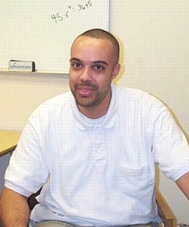What Goes into a Good Department Web site?
 This term one of my duties at Henry Ford CC is to construct the Math
Division’s Web site. As part of my preparation for actually constructing
the site, I’ve been viewing the Web sites of other community colleges (so
far mostly those in Michigan) to determine what content graces their sites.
What follows are some observations about the sites I’ve found. Any
specific references are accurate as of early February 2003.
This term one of my duties at Henry Ford CC is to construct the Math
Division’s Web site. As part of my preparation for actually constructing
the site, I’ve been viewing the Web sites of other community colleges (so
far mostly those in Michigan) to determine what content graces their sites.
What follows are some observations about the sites I’ve found. Any
specific references are accurate as of early February 2003.
Not all math departments have Web sites. The math department sites that do exist, though, tend to have some common information presented in different ways.
Instructor Contact Information
Washtenaw CC, for example, has a page
(http://www.washtenaw.cc.mi.us/dept/math_nat/math/mfaculty.html) with a clean
presentation of contact information. A hotlink to each full-time
instructor’s e-mail address is provided, and a homepage link is provided,
if appropriate. Office hours and teaching schedules are often listed at these
Web sites. The colleges that list full-time math department instructors
separately from instructors in other departments tend to list their adjunct
faculty, too. Some colleges list the degrees earned by their faculty.
Course Descriptions Most math department sites link to pages that contain descriptions of the math courses offered. Some, such as Jackson CC (http://www.jccmi.edu/Departments/MathematicsEngineering/CourseInformation/courseinfo.html), offer the course descriptions in PDF format; others, such as Mid Michigan CC (http://www.midmich.cc.mi.us/math) simply link to a page with an HTML description of the courses. Gogebic CC has some of its syllabi, complete with specific performance objectives, online. (See, for example, http://www.gogebic.cc.mi.us/departments/math_sci_div/syllabus/mth150syl.html). Still others just link to the place in the online college catalog with the math course descriptions.
Placement Test Information Many department sites provide information about mathematics placement testing. In particular, Oakland CC has COMPASS information, including a sample test (http://www.occ.cc.mi.us/MathTest), and the Math Skills Department at Lansing CC has test information and links to sample problems for both placement and proficiency tests (http://www.lcc.edu/mathskills/placement/index.htm).
Other features, although not found uniformly, seem desirable. A flowchart of mathematics department courses is available at some sites (e.g., Kalamazoo Valley CC, at http://puma.kvcc.edu/math/flowchart/MathChart.htm, and Grand Rapids CC, at http://web.grcc.cc.mi.us/math/chart.html). Some sites have links to the college’s schedule of classes, and some have links to upcoming math department schedules in advance of the publishing of the official college schedule. Some have information about on-campus math tutorial labs. Information about transferability of courses may appear. Some departmental home pages contain some sort of math quote, perhaps a “welcome” message from the department chair, and links to other math and math organization sites. Some sites are easily found: Math departments with obvious Web addresses (such as Delta College’s site at http://www.delta.edu/math) and departments with links under Departments headings on their colleges’ homepages, are easily located.
I’m left with a number of questions to consider as the site at Henry Ford CC is developed. Among those:
For whom is the site written? Some of these sites contain pages with content such as adjunct faculty handbooks, guidelines for writing syllabi, and departmental goals. Such content would not likely be of interest to most students who visit the site. How do you “advertise” the site to all who might benefit from it?
Although one person may initially produce the Web site, who maintains it? Are there procedures in place, particularly if more than one person is responsible for the site, to ensure that content and links do not become outdated?
What considerations should be given to users with disabilities, or to users who will use dial-up connections to view the site? Some sites, for example, include faculty pictures on their main page for faculty contact information. Should there be a mostly-text page that includes links to other pages with pictures that visitors may choose to view? Should there be two versions of the site? The math department at Springfield Technical CC in Massachusetts (http://math.stcc.mass.edu/welcome.html) actually has Flash and non-Flash versions of its site.
Over the next few months I’ll try to make sense of the notes I’ve made from different sites, and I’ll try to answer a few of the questions I still have. With any luck, you’ll be able to view the results by late April or so by visiting the Henry Ford CC home page at http://www.hfcc.edu and finding a link to the Web site for the Mathematics Division.
Scott Barnett, Two-year College Vice Chair